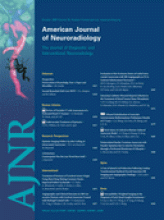That tobacco use and alcohol intake increase the risk for head and neck squamous cell carcinoma (HNSCC) is a fact that all health care professionals, including radiologists, are taught early in their careers.1 Among other molecular events, tobacco causes mutations in the p53 tumor-suppressor gene, leaving the patient at increased risk for malignancy in multiple sites.2 The well-known exception is nasopharyngeal carcinoma, endemic in Southeast Asia and one of the most common cancers.3 Epstein-Barr virus exposure and nuclear antigen presence in epithelial cells have been implicated in HNSCC in the nasopharyngeal subsite. In the United States, populations at risk for this virally associated malignancy are immigrants from Southeast Asia; African-American adolescents have an even higher incidence.4
The recent proved association of human papillomavirus 16 (HPV) and cervical cancer and the development of a protective vaccine resulted in a seismic shift in our understanding of oncogenesis.5 Previously, behavior modification was the only way a patient could potentially affect the risk of developing cancer. Tobacco cessation, limited alcohol intake, sunscreen, and lower estrogen doses to treat menopausal symptoms are among the protective steps available. However, virally mediated tumorigenesis is more common than the North American medical community imagined, and the idea that a protective vaccination had been developed was an exciting addition to the prevention steps a patient could make.
Now, oropharyngeal HPV infection, with the same viral type associated with cervical cancer, HPV 16, has been shown to be strongly associated with HNSCC, especially the tonsil and base of tongue (BOT) subsites.6 Squamous cell carcinoma (SCC) of the oropharynx to date has almost always been associated with tobacco and alcohol exposure, occurred in late middle-aged and elderly patients, and was more common in men. However, patients with HPV-associated oropharyngeal SCC have different demographics. Compared with tobacco- and alcohol-related oropharyngeal SCC, patients with HPV-associated tumors tend to be younger, do not currently or have not ever smoked, and have a better prognosis after chemoradiation therapy.7 Whether populations at risk, including adolescent boys, should be vaccinated against HPV, just as young sexually active girls are now, will be determined by public health officials in the next several years.8
Why is this information important for the neuroradiologist? One of the most common presentations for HPV-related oropharyngeal carcinoma is a new neck mass. Of 198 HPV-positive cases of stage III or IV oropharyngeal SCC, >90% of patients had metastatic adenopathy at presentation (M. Gillison, personal communication, May 2009). Cross-sectional imaging, either CT or MR imaging, is virtually always requested as part of the work-up and staging for the patient with metastatic cervical adenopathy.
The nodes associated with HPV-related SCC are usually in level IIa, ipsilateral to the primary tumor, and are either necrotic or truly cystic.9 Furthermore, the primary tumor in the tonsil or BOT may be small and, unless the radiologist suspects the diagnosis, can be easily overlooked.
Consider the other lesion that can present in this location. The second branchial cleft cyst is a non-nodal congenital lesion, also presents as a cystic structure in level IIa, and usually presents in the first 2 decades of life. Second branchial cleft cysts are unilocular, smooth, and well-circumscribed, with no associated stranding or induration of surrounding structures, significant wall enhancement, or enhancing nodule. Rarely, if infected, the cyst may display minimal enhancement, but that is definitely the exception to the rule. Even when it presents after 30 years of age, the patient will often give a history of chronic neck fullness or mass following an upper respiratory infection. Contrast that to nodal metastases from tobacco-induced SCC of the oropharynx, when the patient has no history of a prior neck mass. It is my experience, as part of a team caring for patients with HNSCC, that a Level IIa necrotic node is often described by radiologists as a “branchial cleft cyst,” despite the fact that the patient is older, has risk factors for SCC, and has no history of neck mass. This misdiagnosis may lead to delay in diagnosis and treatment.
With the emergence of virally induced oropharyngeal carcinoma that presents with nodal metastases, the radiology community must be especially careful about interpreting every cystic neck lesion as a branchial cleft cyst. HPV-positive nodal metastases may be necrotic or may also be truly cystic, and a diagnosis of HNSCC must be considered strongly before dismissing the mass as a congenital lesion. That younger nonsmokers can get oropharyngeal carcinoma is a new and worrisome phenomenon. Beware the “second branchial cleft cyst” diagnosis when reading CT, MR imaging, or even sonography of the neck. The adult patient with a new neck mass, unless it is midline and obviously a goiter, has SCC nodal metastases until proved otherwise. End of case.
References
- Copyright © American Society of Neuroradiology












